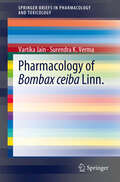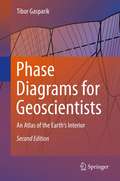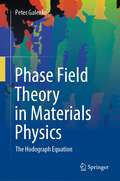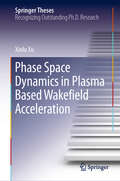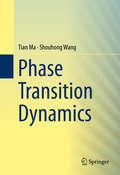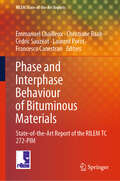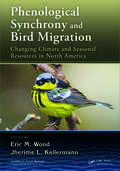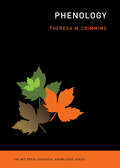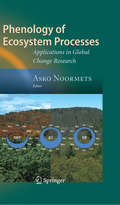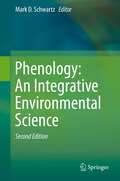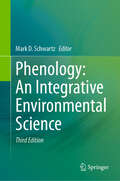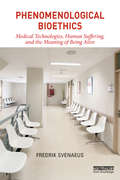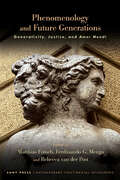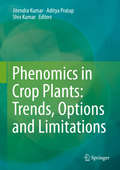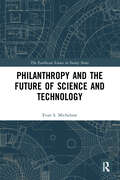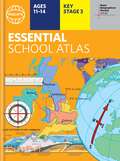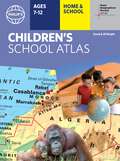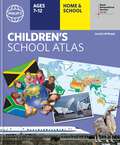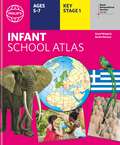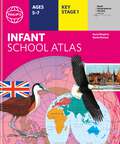- Table View
- List View
Pharmacology of Bombax ceiba Linn.
by Vartika Jain Surendra K. VermaThis work is the first monograph devoted solely to Bombax ceiba, popularly known as the Red Silk Cotton Tree. Consisting of seven chapters, it covers all relevant aspects of this plant, from its historical and spiritual importance, to its botanical characterization, pharmacognostical details and ethnobiological uses, to its scientific validation in various animal and human studies. Each part of the tree is of medicinal value and possesses many novel chemical constituents such as shamimicin, bombasin, bombamalone, bombamaloside etc. along with other bioactive secondary metabolites. The book presents the chemical structures of the most important constituents and highlights various pharmacological activities, predominantly antioxidant, anti-inflammatory, anti-mutagenic, hypoglycemic, hypotensive, hepatoprotective and fibrinolytic, which may prove to be a source for the development of a novel phyto-pharmaceutical agent to treat diabetes, heart disease and cancer. In addition, separate chapters deal with the commercial and ecological significance of B. ceiba, as well as a case study on its conservation. Numerous color illustrations are included to identify the plant and to justify its nickname, the "Little Bird's Cafeteria".
Phase Diagrams for Geoscientists: An Atlas of the Earth's Interior
by Tibor GasparikThe book summarizes the results of the experimental studies of phase relations in the chemical systems relevant to Earth, carried out by the author in a time period of over 20 years between 1979 and 2001. It is based on 1000 piston-cylinder experiments at pressures up to 4 GPa, and close to 700 experiments carried out with a multi-anvil apparatus at pressures up to 24 GPA. This is the largest published collection of calculated phase diagrams for the chemical systems relevant to Earth. This is also the first time that the phase relations at the relatively low pressures of the lithospheric mantle, mainly applicable to the experimental thermobarometry of metamorphic rocks and mantle xenoliths, are seamlessly integrated with the phase relations of the sublithospheric upper mantle and the uppermost lower mantle, primarily applicable to inclusions in diamond and schocked meteorites. "Tibor Gasparik has devoted his career to determining the high-pressure, high-temperature phase relations of the geologically important Sodium-Calcium-Magnesium-Aluminium-Silicon (NCMAS) oxide system. This book is his opus magnum, summarizing more than 1700 experiments in over 120 figures. ... I have found Phase Diagrams for Geoscientists to be a useful first port-of-call for finding the P-T stability fields ... and I can recommend the book as a reference for geoscientists requiring an overview of the stable phase assemblages in the top 700 km of the Earth." (David Dobson, Geological Magazine, Vol. 142 (2), 2005)
Phase Field Theory in Materials Physics: The Hodograph Equation
by Peter GalenkoThis book deals with the use of the hodograph equation in phase transformations in condensed matter, especially, for crystallization and solidification processes. The main focus of the book is the interpretation of the phase-field equations for isotropic and anisotropic interfaces based on the advanced Gibbs–Thomson and Herring conditions, respectively. Beginning with the basic ideas behind the extended irreversible thermodynamics, the kinetic phase-field model for slow and arbitrarily fast phase transformations is derived where the unified hodograph equation follows from:• the sharp interface limit of the diffuse interface or• the traveling wave solution of the propagating phase field.Under the example of solute trapping and disorder trapping effects, comparing theoretical results with molecular dynamics simulations, and with the analysis of experimental data, the concrete workability of the developed hodograph equation is demonstrated for widest range of driving force in phase transformations.
Phase Space Dynamics in Plasma Based Wakefield Acceleration (Springer Theses)
by Xinlu XuThis book explores several key issues in beam phase space dynamics in plasma-based wakefield accelerators. It reveals the phase space dynamics of ionization-based injection methods by identifying two key phase mixing processes. Subsequently, the book proposes a two-color laser ionization injection scheme for generating high-quality beams, and assesses it using particle-in-cell (PIC) simulations. To eliminate emittance growth when the beam propagates between plasma accelerators and traditional accelerator components, a method using longitudinally tailored plasma structures as phase space matching components is proposed. Based on the aspects above, a preliminary design study on X-ray free-electron lasers driven by plasma accelerators is presented. Lastly, an important type of numerical noise—the numerical Cherenkov instabilities in particle-in-cell codes—is systematically studied.
Phase Transition Dynamics
by Shouhong Wang Tian MaThis book is an introduction to a comprehensive and unified dynamic transition theory for dissipative systems and to applications of the theory to a range of problems in the nonlinear sciences. The main objectives of this book are to introduce a general principle of dynamic transitions for dissipative systems, to establish a systematic dynamic transition theory, and to explore the physical implications of applications of the theory to a range of problems in the nonlinear sciences. The basic philosophy of the theory is to search for a complete set of transition states, and the general principle states that dynamic transitions of all dissipative systems can be classified into three categories: continuous, catastrophic and random. The audience for this book includes advanced graduate students and researchers in mathematics and physics as well as in other related fields.
Phase Transitions in Materials
by Brent FultzOffering a fresh viewpoint on phase changes and the thermodynamics of materials, this textbook covers the thermodynamics and kinetics of the most important phase transitions in materials science, spanning classical metallurgy through to nanoscience and quantum phase transitions. Clear, concise and complete explanations rigorously address transitions from the atomic scale up, providing the quantitative concepts, analytical tools and methods needed to understand modern research in materials science. Topics are grouped according to complexity, ensuring that students have a solid grounding in core topics before they begin to tackle more advanced material, and are accompanied by numerous end-of-chapter problems. With explanations firmly rooted in the context of modern advances in electronic structure and statistical mechanics, and developed from classroom teaching, this book is the ideal companion for graduate students and researchers in materials science, condensed matter physics, solid state science, and physical chemistry.
Phase and Interphase Behaviour of Bituminous Materials: State-of-the-Art Report of the RILEM TC 272-PIM (RILEM State-of-the-Art Reports #43)
by Francesco Canestrari Laurent Porot Christiane Raab Emmanuel Chailleux Cédric SauzéatThis book presents the work of the RILEM Technical Committee 272-PIM on Phase and Interphase behaviour of Bituminous Materials and showcases advances and innovations in the field of bituminous materials for flexible pavements. The first section delves into complex and combined binders, unravelling intricate phenomena and shedding light on the unique challenges posed by these materials. Through meticulous cross-testing, the fundamental physical processes are better understood. The second section addresses the low-temperature performance of bituminous mixtures, exploring important behaviour regarding the longevity and resilience of bituminous pavements. The use of innovative methodologies, particularly the restrained shrinkage test exploited using a three-dimensional perspective, enriches the understanding regarding the mechanical behaviour at cold temperatures. The third section delves into dynamic interlayer shear testing, providing a comprehensive guide to evaluate the bonding behaviour of bituminous interlayers under cyclic loadings. By considering the multiphase nature of road materials and structures, the book not only fills gaps in existing knowledge but also lays the foundation for the development of more durable materials. Its emphasis on a performance-driven and internationally validated approach makes it a reference tool for those contributing to the advancement of sustainable materials in the field of bituminous material engineering.
Phenological Synchrony and Bird Migration: Changing Climate and Seasonal Resources in North America (Studies in Avian Biology)
by Eric M. Wood Jherime L. KellermannBird migration is a well-researched phenological event. However, few studies in North America have investigated the effects of climate change and extreme weather on the relationships of migratory avian species and their seasonal resources. This is a critical gap in knowledge that limits our ability to prioritize management and conservation applicat
Phenology (The MIT Press Essential Knowledge series)
by Theresa M. CrimminsOn the timing of seasonal activity in plants and animals, the impact of climate change, and what each of us, as everyday phenologists, can do to help.Phenology is all about timing—when trees leaf out, flowers bloom, birds migrate, animals bear young and hibernate—and it is everywhere around us. This handy companionable volume shows how we are all phenologists in our own way, and how the everyday science can help us make sense of the changing seasons and our changing world. Explaining how the phenomenon of phenology is threaded through our daily lives, Theresa Crimmins points to events that occur on an annual basis in plants’ and animals’ lives in response to fluctuations in daylength, temperatures, and rainfall patterns. She also covers less visible seasonal events, such as when roots typically begin to grow or when mushrooms release their spores. On a more urgent note, Phenology describes how this seasonal activity is being affected by rapidly changing climate conditions—and why this matters. Consequently, the book invites readers to participate in documenting the timing of seasonal life cycle events—for the practice’s real benefits to mental health, but also for the good of the environment, as the data gathered can be directly helpful in supporting climate change action.
Phenology of Ecosystem Processes
by Asko NoormetsTerrestrial carbon balance is uncertain at the regional and global scale. A significant source of variability in mid-latitude ecosystems is related to the timing and duration of phenological phases. Spring phenology, in particular, has disproportionate effects on the annual carbon balance. However, the traditional phenological indices that are based on leaf-out and flowering times of select indicator species are not universally amenable for predicting the temporal dynamics of ecosystem carbon and water exchange. Phenology of Ecosystem Processes evaluates current applications of traditional phenology in carbon and H2O cycle research, as well as the potential to identify phenological signals in ecosystem processes themselves. The book summarizes recent progress in the understanding of the seasonal dynamics of ecosystem carbon and H2O fluxes, the novel use of various methods (stable isotopes, time-series, forward and inverse modeling), and the implications for remote sensing and global carbon cycle modeling. Each chapter includes a literature review, in order to present the state-of-the-science in the field and enhance the book's usability as an educational aid, as well as a case study to exemplify the use and applicability of various methods. Chapters that apply a specific methodology summarize the successes and challenges of particular methods for quantifying the seasonal changes in ecosystem carbon, water and energy fluxes. The book will benefit global change researchers, modelers, and advanced students.
Phenology: An Integrative Environmental Science
by Mark D. SchwartzPhenology refers to recurring plant and animal life cycle stages, such as leafing and flowering, maturation of agricultural plants, emergence of insects, and migration of birds. It is also the study of these recurring events, especially their timing and relationships with weather and climate. Phenological phenomena all give a ready measure of the environment as viewed by the associated organism, and are thus ideal indicators of the impact of local and global changes in weather and climate on the earth's biosphere. Assessing our changing world is a complex task that requires close cooperation from experts in biology, climatology, ecology, geography, oceanography, remote sensing, and other areas. Like its predecessor, this second edition of Phenology is a synthesis of current phenological knowledge, designed as a primer on the field for global change and general scientists, students, and interested members of the public. With updated and new contributions from over fifty phenological experts, covering data collection, current research, methods, and applications, it demonstrates the accomplishments, progress over the last decade, and future potential of phenology as an integrative environmental science.
Phenology: An Integrative Environmental Science
by Mark D. SchwartzPhenology refers to recurring plant and animal life cycle stages, such as leafing and flowering, maturation of agricultural plants, emergence of insects, and migration of birds. It is also the study of these recurring events, especially their timing and relationships with weather and climate. Phenological phenomena all give a ready measure of the environment as viewed by the associated organism and are thus ideal indicators of the impact of local and global changes in weather and climate on the earth’s biosphere. Assessing our changing world is a complex task that requires close cooperation from experts in biology, climatology, ecology, geography, oceanography, remote sensing, and other areas. Like its two predecessors, this third edition of Phenology is a synthesis of current phenological knowledge, designed as a primer on the field for global change and general scientists, students, and interested members of the public. With updated and new contributions from over sixty phenological experts, covering data collection, current research, methods, and applications, it demonstrates the accomplishments, progress over the last decade, and future potential of phenology as an integrative environmental science.
Phenomenological Bioethics: Medical Technologies, Human Suffering, and the Meaning of Being Alive
by Fredrik SvenaeusEmerging medical technologies are changing our views on human nature and what it means to be alive, healthy, and leading a good life. Reproductive technologies, genetic diagnosis, organ transplantation, and psychopharmacological drugs all raise existential questions that need to be tackled by way of philosophical analysis. Yet questions regarding the meaning of life have been strangely absent from medical ethics so far. This book brings phenomenology, the main player in the continental tradition of philosophy, to bioethics, and it does so in a comprehensive and clear manner. Starting out by analysing illness as an embodied, contextualized, and narrated experience, the book addresses the role of empathy, dialogue, and interpretation in the encounter between health-care professional and patient. Medical science and emerging technologies are then brought to scrutiny as endeavours that bring enormous possibilities in relieving human suffering but also great risks in transforming our fundamental life views. How are we to understand and deal with attempts to change the predicaments of coming to life and the possibilities of becoming better than well or even, eventually, surviving death? This is the first book to bring the phenomenological tradition, including philosophers such as Martin Heidegger, Edith Stein, Maurice Merleau-Ponty, Jean-Paul Sartre, Hans-Georg Gadamer, Paul Ricoeur, Hans Jonas, and Charles Taylor, to answer such burning questions.
Phenomenology and Future Generations: Generativity, Justice, and Amor Mundi (SUNY series in Contemporary Continental Philosophy)
by Matthias Fritsch, Ferdinando G. Menga and Rebecca van der PostIn the face of widespread environmental and social destabilization and growing uncertainty about the future of humanity, this collection of essays brings the philosophical tradition of phenomenology to the question of relations between generations to examine our ethical, political, and environmental obligations to future people. Emphasizing phenomenology's rich reflections on the role of time in the constitution of the social-historical world and its relation to the environment, the essays interweave the central themes of mortality, natality, generativity, and amor mundi to build vital bridges between new developments in both eco- and critical phenomenology and important work in intergenerational ethics. Together, the chapters reevaluate the traditional scope and foundational concepts of environmental ethics and social justice, paving the way for a revised understanding of intergenerational responsibilities, culminating in the key insight that future people are of us. The result is an invaluable conceptual toolkit for phenomenologists, ethicists, theorists, students, and activists concerned with environmental justice and climate ethics.
Phenomics in Crop Plants: Trends, Options and Limitations
by Aditya Pratap Jitendra Kumar Shiv KumarIdentification of desirable genotypes with traits of interest is discernible for making genetic improvement of crop plants. In this direction, screening of a large number of germplasm for desirable traits and transfer of identified traits into agronomic backgrounds through recombination breeding is the common breeding approach. Although visual screening is easier for qualitative traits, its use is not much effective for quantitative traits and also for those, which are difficult to score visually. Therefore, it is imperative to phenotype the germplasm accessions and breeding materials precisely using high throughput phenomics tools for challenging and complex traits under natural, controlled and harsh environmental conditions. Realizing the importance of phenotyping data towards identification and utilization of a germplasm as donors, global scientific community has exerted increased focus on advancing phenomics in crop plants leading to development of a number of techniques and methodologies for screening of agronomic, physiological, and biochemical traits. These technologies have now become much advanced and entered the era of digital science. This book provides exhaustive information on various aspects related to phenotyping of crop plants and offers a most comprehensive reference on the developments made in traditional and high throughput phenotyping of agricultural crops.
Philanthropy and the Future of Science and Technology (The Earthscan Science in Society Series)
by Evan S. MichelsonAn increasingly important and often overlooked issue in science and technology policy is recognizing the role that philanthropies play in setting the direction of research. In an era where public and private resources for science are strained, the practices that foundations adopt to advance basic and applied research needs to be better understood. This first-of-its-kind study provides a detailed assessment of the current state of science philanthropy. This examination is particularly timely, given that science philanthropies will have an increasingly important and outsized role to play in advancing responsible innovation and in shaping how research is conducted. Philanthropy and the Future of Science and Technology surveys the landscape of contemporary philanthropic involvement in science and technology by combining theoretical insights drawn from the responsible research and innovation (RRI) framework with empirical analysis investigating an array of detailed examples and case studies. Insights from interviews conducted with foundation representatives, scholars, and practitioners from a variety of sectors add real-world perspective. A wide range of philanthropic interventions are explored, focusing on support for individuals, institutions, and networks, with attention paid to the role that science philanthropies play in helping to establish and coordinate multi-sectoral funding partnerships. Novel approaches to science philanthropy are also considered, including the emergence of crowdfunding and the development of new institutional mechanisms to advance scientific research. The discussion concludes with an imaginative look into the future, outlining a series of lessons learned that can guide how new and established science philanthropies operate and envisioning alternative scenarios for the future that can inform how science philanthropy progresses over the coming decades. This book offers a major contribution to the advancement of philanthropic investment in science and technology. Thus, it will be of considerable interest to researchers and students in public policy, public administration, political science, science and technology studies, sociology of science, and related disciplines.
Philip's Essential School Atlas (Philip's World Atlas #25)
by Philip's Maps"An excellent world atlas. Very illuminating, good colours, clear texts...good glossary and, last but not least, up-to-date". Amazon customer review- The ideal school atlas for Key Stage 3 pupils and Scotland's National Qualifications., 11-14 years old- All updated for 2024 specifically to meet curriculum needs- Specially focused 16-page UK and Ireland section- Comprehensive 62-page world section includes thematic maps on the environment, climate change, people, quality of life, and energy- Published in association with the Royal Geographical SocietyPhilip's RGS Essential School Atlas has been specially created for lower-secondary geography students (11-14 year olds). The maps have been carefully designed to be uncluttered and easy to read, containing specially selected place names and detail. A clear set of symbols and scale information accompanies every map, with a useful introductory section covering basic atlas skills, including aerial photographs and satellite images to further explain particular features on the maps. Latitude and longitude co-ordinates are included in the index, alongside figure-letter references. Fully up-to-date, the atlas includes detailed regional maps, charts and satellite images of Europe, Italy, the Middle East, China, Japan, Kenya, USA, Brazil, and the Arctic and Antarctica. It also focuses on areas of special interest for students of geography, such as Japan's volcanoes and earthquakes, and conservation in Kenya.Philip's RGS Essential School Atlas is ideal for special project work and is available in both hardback and paperback editions.
Philip's Essential School Atlas (Philip's World Atlas #25)
by Philip's Maps"An excellent world atlas. Very illuminating, good colours, clear texts...good glossary and, last but not least, up-to-date". Amazon customer review- The ideal school atlas for Key Stage 3 pupils and Scotland's National Qualifications., 11-14 years old- All updated for 2024 specifically to meet curriculum needs- Specially focused 16-page UK and Ireland section- Comprehensive 62-page world section includes thematic maps on the environment, climate change, people, quality of life, and energy- Published in association with the Royal Geographical SocietyPhilip's RGS Essential School Atlas has been specially created for lower-secondary geography students (11-14 year olds). The maps have been carefully designed to be uncluttered and easy to read, containing specially selected place names and detail. A clear set of symbols and scale information accompanies every map, with a useful introductory section covering basic atlas skills, including aerial photographs and satellite images to further explain particular features on the maps. Latitude and longitude co-ordinates are included in the index, alongside figure-letter references. Fully up-to-date, the atlas includes detailed regional maps, charts and satellite images of Europe, Italy, the Middle East, China, Japan, Kenya, USA, Brazil, and the Arctic and Antarctica. It also focuses on areas of special interest for students of geography, such as Japan's volcanoes and earthquakes, and conservation in Kenya.Philip's RGS Essential School Atlas is ideal for special project work and is available in both hardback and paperback editions.
Philip's RGS Children's School Atlas (Philip's World Atlas #26)
by David Wright Jill Wright Philip's Maps Rachel Noonan"This is such a great book for primary school age children and a little beyond for finding out about the world, its countries and people" Amazon customer review- Philip's atlas, designed specially to use at home and at school with guidance for parents and teachers- Clear maps and fascinating facts bring geography to life for readers aged 7-12- Published by Philip's the UK's leading school atlas publisher, in association with the Royal Geographical Society- Quizzes, activity ideas and puzzles to make learning fun- Past winner of the Geographical Association's award for making a significant contribution to geographyThe atlas is organized spread by spread in the classic sequence: first Europe, then its land neighbour Asia, followed by Africa, Australia and Oceania, North America and South America.Illustrated with captivating full-colour photographs and packed with fact boxes, curiosities, flags, stamps and quiz questions, Philip's RGS Children's Atlas is both fun to use and easy to understand.Now in its 16th edition, Philip's RGS Children's Atlas is a past winner of the Geographical Association's award for making a significant contribution to geography. The atlas was judged "an excellent 'all round' children's atlas with simple yet well-designed maps, well-illustrated with colour photographs. It links places to issues, events and real people, giving a clear sense of place."
Philip's RGS Children's School Atlas (Philip's World Atlas #26)
by David Wright Jill Wright Philip's Maps Rachel Noonan"This is such a great book for primary school age children and a little beyond for finding out about the world, its countries and people" Amazon customer review- Philip's atlas, designed specially to use at home and at school with guidance for parents and teachers- Clear maps and fascinating facts bring geography to life for readers aged 7-12- Published by Philip's the UK's leading school atlas publisher, in association with the Royal Geographical Society- Quizzes, activity ideas and puzzles to make learning fun- Past winner of the Geographical Association's award for making a significant contribution to geographyThe atlas is organized spread by spread in the classic sequence: first Europe, then its land neighbour Asia, followed by Africa, Australia and Oceania, North America and South America.Illustrated with captivating full-colour photographs and packed with fact boxes, curiosities, flags, stamps and quiz questions, Philip's RGS Children's Atlas is both fun to use and easy to understand.Now in its 16th edition, Philip's RGS Children's Atlas is a past winner of the Geographical Association's award for making a significant contribution to geography. The atlas was judged "an excellent 'all round' children's atlas with simple yet well-designed maps, well-illustrated with colour photographs. It links places to issues, events and real people, giving a clear sense of place."
Philip's RGS Children's Atlas (Philip's World Atlas #27)
by David Wright Jill Wright Philip's Maps"This is such a great book for primary school age children and a little beyond for finding out about the world, its countries and people" Amazon customer review- Philip's atlas, designed specially to use at home and at school with guidance for parents and teachers- Clear maps and fascinating facts bring geography to life for readers aged 7-12- Published by Philip's in association with the Royal Geographical Society- Quizzes, activity ideas and puzzles to make learning fun- Past winner of the Geographical Association's award for making a significant contribution to geographyThe atlas is organized spread by spread in the classic sequence: first Europe, then its land neighbour Asia, followed by Africa, Australia and Oceania, North America and South America. Illustrated with captivating full-colour photographs and packed with fact boxes, curiosities, flags, stamps and quiz questions, Philip's RGS Children's Atlas is both fun to use and easy to understand.Now in its 17th edition, Philip's RGS Children's Atlas is a past winner of the Geographical Association's award for making a significant contribution to geography. The atlas was judged "an excellent 'all round' children's atlas with simple yet well-designed maps, well-illustrated with colour photographs. It links places to issues, events and real people, giving a clear sense of place."
Philip's RGS Children's Atlas (Philip's World Atlas #27)
by David Wright Jill Wright Philip's Maps"This is such a great book for primary school age children and a little beyond for finding out about the world, its countries and people" Amazon customer review- Philip's atlas, designed specially to use at home and at school with guidance for parents and teachers- Clear maps and fascinating facts bring geography to life for readers aged 7-12- Published by Philip's in association with the Royal Geographical Society- Quizzes, activity ideas and puzzles to make learning fun- Past winner of the Geographical Association's award for making a significant contribution to geographyThe atlas is organized spread by spread in the classic sequence: first Europe, then its land neighbour Asia, followed by Africa, Australia and Oceania, North America and South America. Illustrated with captivating full-colour photographs and packed with fact boxes, curiosities, flags, stamps and quiz questions, Philip's RGS Children's Atlas is both fun to use and easy to understand.Now in its 17th edition, Philip's RGS Children's Atlas is a past winner of the Geographical Association's award for making a significant contribution to geography. The atlas was judged "an excellent 'all round' children's atlas with simple yet well-designed maps, well-illustrated with colour photographs. It links places to issues, events and real people, giving a clear sense of place."
Philip's RGS Infant School Atlas: Key Stage 1 (Ages 5-7) (Philip's World Atlas #27)
by David Wright Philip's Maps Rachel NoonanWritten for 5 to 7 year-old this atlas is ideal for teaching Key Stage 1, helping to cover geography, history, science, citizenship and literacy requirements- Written by experts Professor David Wright and Rachel Noonan- Published in association with the Royal Geographical Society- 50 pages of clear, child-friendly maps showing our world today- Countries of the world brought to life with flags, illustrations and photos- Bold text, simple words and short sentences to encourage reading skills- Starts with the Earth as a Planet then zooms into each of the world's regions with maps and illustrations- Numbered balloons on each map link to photos of a real placeFully revised and updated, the atlas is for children aged 5-7 in the early stages of reading, with simple text to explain what is happening on the maps and illustrations - all compatible with National Curriculum Key Stage 1.Clear, child-friendly maps are combined with vibrant photographs and facts about the world. Guidance is given at the beginning of the atlas on how to use the maps, encouraging the early development of map skills. Each colourful spread is illustrated with photographs and packed with fact boxes, curiosities, flags, stamps and simple quiz questions. Philip's RGS Infant School Atlas is both fun to use and easy to understand. The text is simple and uncomplicated to encourage early reading skills.
Philip's RGS Infant School Atlas: Key Stage 1 (Ages 5-7) (Philip's World Atlas #27)
by David Wright Philip's Maps Rachel NoonanWritten for 5 to 7 year-old this atlas is ideal for teaching Key Stage 1, helping to cover geography, history, science, citizenship and literacy requirements- Written by experts Professor David Wright and Rachel Noonan- Published in association with the Royal Geographical Society- 50 pages of clear, child-friendly maps showing our world today- Countries of the world brought to life with flags, illustrations and photos- Bold text, simple words and short sentences to encourage reading skills- Starts with the Earth as a Planet then zooms into each of the world's regions with maps and illustrations- Numbered balloons on each map link to photos of a real placeFully revised and updated, the atlas is for children aged 5-7 in the early stages of reading, with simple text to explain what is happening on the maps and illustrations - all compatible with National Curriculum Key Stage 1.Clear, child-friendly maps are combined with vibrant photographs and facts about the world. Guidance is given at the beginning of the atlas on how to use the maps, encouraging the early development of map skills. Each colourful spread is illustrated with photographs and packed with fact boxes, curiosities, flags, stamps and simple quiz questions. Philip's RGS Infant School Atlas is both fun to use and easy to understand. The text is simple and uncomplicated to encourage early reading skills.
Philip's RGS Infant's School Atlas (Philip's World Atlas #27)
by David Wright Jill Wright Philip's MapsWritten for 5 to 7 year-old this atlas is ideal for teaching Key Stage 1, helping to cover geography, history, science, citizenship and literacy requirements- Written by experts Professor David Wright and Rachel Noonan- Published in association with the Royal Geographical Society- 50 pages of clear, child-friendly maps showing our world today- Countries of the world brought to life with flags, illustrations and photos- Bold text, simple words and short sentences to encourage reading skills- Starts with the Earth as a Planet then zooms into each of the world's regions with maps and illustrations- Numbered balloons on each map link to photos of a real placeFully revised and updated, the atlas is for children aged 5-7 in the early stages of reading, with simple text to explain what is happening on the maps and illustrations - all compatible with National Curriculum Key Stage 1.Clear, child-friendly maps are combined with vibrant photographs and facts about the world to provide essential geographical information for young children. Guidance is given at the beginning of the atlas on how to use the maps, encouraging the early development of map skills and knowledge of the world. Each colourful spread is illustrated with photographs and packed with fact boxes, curiosities, flags, stamps and simple quiz questions. Philip's RGS Infant School Atlas is both fun to use and easy to understand. The text is simple and uncomplicated to encourage early reading skills.
